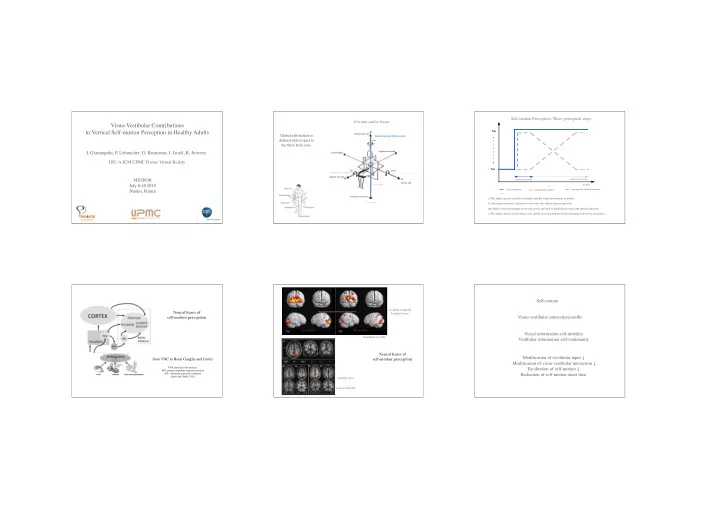

Self-motion Perception: Three perceptual steps Circular and/or linear Visuo-Vestibular Contributions to Vertical Self-motion Perception in Healthy Adults Va Z Vertical upward Global self-motion is Vertical Upward & Downward v v i t e s s e defined with respect to yaw e the three body axes. l o Sagittal backward c I. Giannopulu, P. Leboucher, G. Rautureau, I. Israël, R. Jouvent Lateral Right i t IHU-A-ICM UPMC Prisme Virtual Reality y Vo roll pitch délai de vection délai de saturation Sagittal forward MESROB vection onset time vection saturation Lateral Left July 8-10 2015 t i m e t e m p s visual stimulation self-motion perception perception of visual environment Nantes, France stimulation visuelle perception du mouvement de soi perception du mouvement Vertical downward de l'environnement visuel a) The subject perceives itself as stationary and the visual environment as mobile. b) After same onset time (self-motion onset time) the subject begins to perceive the mobile visual environment as moving slowly and itself as gradually moving in the opposite direction. c) The subject perceives self-motion only and the visual environment looks stationary (self-motion saturation) . vection onset Self-motion occipital, temporal Neural bases of linear and circular self-motion perception & parietal areas Visuo-vestibular interaction/conflit self-motion perception Visual information self-mobility Deutschlander et al., 2004 Vestibular information self-stationarity Neural bases of Modification of vestibular input ↓ from VNC to Basal Ganglia and Cortex self-motion perception Modification of visuo-vestibular interaction ↓ PFN: parafascicular nucleus; Facilitation of self-motion ↓ PPT: pedunculopontine tegmental nucleus SNc: substantia nigra pars compacta Reduction of self-motion onset time (Stiles and Smith, 2015) parietal areas Cardin & Smith, 2010
Vertical axis (Z): Intra-axis Comparison horizontal movement X axis saccular maculae ⟩ Utricular maculae Many characteristics of self-motion perception have been found to depend on the intensity of the conflict between visual and (e.g. Fernandez et al., 1972; Tomko et al., 1981) - In healthy subjects, the otolith stimulation appears to modify vestibular inputs. vertical the cardiovascular activity measured by the heart rate (p.e. movement Z axis ⟩ ⟨ Olufsen et al., 2008) Upward Saccular Sensibility Downward - Patients with reduced vestibular sensitivity (Menière’s patients) (p.e Howard, 1986; De Saedeleer et al. 2013; Pfeiffer et al., 2014) have traditionally shorter self-motion onset time than healthy control subjects (e.g Wong & Frost, 1978, 1981; Cheung et al., 1st Hypothesis 1990). - The heart rate is lower in patients (Meniere's patients) suffering from bilateral vestibular disorder than in controls ⟩ ⟨ Self-motion Perception - Vestibular healthy subjects have shorter self-motion perception Upward Downward (p.e. Yates et al., 1999) Onset Time onset time in microgravity than on earth gravity (e.g. Young & Shelhamer, 1990). Vertical axis (Z): Relationship between vestibular and cardiovascular systems 35/40 participants (17 males & 18 females) Mean Age: 26 years old HMD without neurological, visuo-vestibular, cardiac and/or psychiatric disorders ⟩ Saccular Sensibility ⟨ Upward Downward HMD, SONY HMZ- T1 (p.e Howard, 1986; De Saedeleer et al. 2013; Pfeiffer et al., 2014) Method key-bouton 2nd Hypothesis Vertical upward Z Cardiofrequence MIO Cardio-vascular activity Upward ⟩ ⟨ Downward (bpm) Electrodermal activity Vertical downward
Heart rate for downward and upward self-motion Upward Downward 10 105 8 95 heart rate (bpm) 6 85 LRSM/s Results 4 75 2 65 0 55 3 5 6 4 9 5 7 7 8 1 3 9 3 5 2 7 0 2 3 s 2 3 1 3 s 1 2 3 1 s 2 s 2 3 s 9 Rest Upward Downward s s s s s s s s s s s s s Onset time of reporting downward and upward self-motion Asymmetry on onset time between No asymmetry on onset time between opposite directions within vertical axis opposite directions within vertical axis Vertical upward Z Discussion HMD, SONY HMZ-T1 Evaluation of visual-vestibular interaction in the perception of angular self-motion (Zacharias & Young, 19981). The existence of a reference signal visually generated. This signal corresponds to the vestibular dynamic that would be expected if the subject was Vertical downward really in motion within a stationary environment. In this context, the visuo-vestibular conflict corresponds to the difference between the current vestibular dynamic of the stationary subject and the expected vestibular dynamic (Zacharias & Young, 1981, Palmisano et al., 2000; Palmisano et al., 2003). Lepecq et al, (1999); Kano, 1994
Visuo-vestibular interaction could be considered as a minimalistic model for spatial navigation of humanoid robots. Most robots do not use a vestibular system but stabilise upright position by means of center of pressure control (COP). We suggest using a biologically inspired vestibular sensor (canal-otolith system) along with a human-inspired control mechanism. The idea is to simulate a vestibular sensor based on 1) Motion sickness development, i.e., vestibular anthropomorphic measures and to implement it into the human-inspired stance control over-stimulation linked to self-motion The intra-individual variability of the vestibular sensitivity on of robot. perception is accompanied by an increase in the vertical axes would explain the intra-individual variability sympathetic activity (and an decrease in of: parasympathetic activity) (Grant et al., 1991) 2) Visually mediated illusory tilt associated to 1. self-motion perception onset time self-motion perception induces dissociation 2. cardiovascular activity in the autonomous nervous system (increased heart rate) (Wood et al., 2007) Cardiovascular responses would be “vestibuloform” Yates, Holmes and JIAN (2000) Yates, Holmes and JIAN (2000) Thank you for your attention
Recommend
More recommend